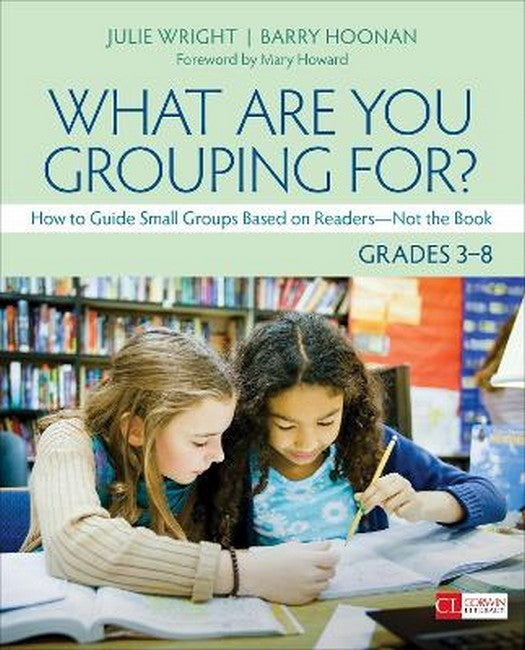Foreword by Mary Howard Acknowledgments Preface CHAPTER 1. A New Way of Thinking About Small Group Learning Experiences (because being up close to students is what drives discovery) Small Group Instruction Redefined The Five Teacher Moves Combating the Challenges So You Can Do the Five Moves One Last Thing CHAPTER 2. The Launch (because who doesn't need beginning-of-the-year strategies) Small Groups Defined Two Essential Questions This Chapter Helps You Answer Beliefs Ideas for the First Days of School Listening In and Joining In A Few Weeks Into the School Year One Last Thing CHAPTER 3. Scheduling (because schedules are key for the launch and beyond) Reading Workshop: Daily Plans for Groups Getting Started, Quick Groups Groups for First Days/Weeks of School Groups That Might Meet Across the Year Small Group Foundational Q&A One Last Thing CHAPTER 4. Kidwatching 2.0 (because it's all about orient, notice, take stock, and inquire) Two Essential Questions This Chapter Helps You Answer Beliefs Our Kidwatching 2.0 Protocol Tips for Getting Started Using Your Notes to Form Small Groups Four-Step Process for Going From Kidwatching to Small Group Example of Small Group Work Based on Kidwatching Data One Last Thing CHAPTER 5. Pivoting Into Flexible Groups (because it's the teacher moves that keep readers moving forward) Two Essential Questions This Chapter Helps You Answer Beliefs How This Chapter Is Organized The List of Reasons for Pivoting The Teacher's Role Types of Groups to Pivot Into and Out Of Timing Is Everything: More About the Duration of Groups Language for Joining In Troubleshooting One Last Thing CHAPTER 6. Assessing Student Work (because looking at our readers' work lifts their strategies, skills, and thinking) Two Essential Questions This Chapter Helps You Answer Beliefs Assessing With Learner-Centered Benchmarks What to Look At How to Sort Student Work Planning a Focus for Instruction and Putting It Into Action More Examples of How to Use Work to Inform Grouping Decisions One Last Thing CHAPTER 7. Curating (because selecting the right texts inspires readers to be connoisseurs) Two Essential Questions This Chapter Helps You Answer Beliefs Teachers and Students as Curators Teachers as Curators Steps for Curating Zooming In on Step 2: Curate and Select Zooming In on Step 3: Decide Steps 4-7: Spark, Read and Construct Meaning, and Reflect Students as Curators Exemplars of Students as Curators One Last Thing CHAPTER 8. Unit Planning (because small groups are best anchored in a harbor of big ideas) Two Essential Questions Chapters Eight and Nine Help You Answer Beliefs Planning: The Reality Show Six Surefire Steps One Last Thing CHAPTER 9. Weekly and Daily Planning (because weekly and daily plans chart the course for small group experiences) Creating a Calendar for Weekly and Daily Lesson Planning Zooming In on Step 5: Make Plans for Small Group Learning Opportunities Some Popular, Proven Models to Guide You Barry's Planning Process for Hosting Two Groups Julie's One-Week Plan of Lessons for Launching a Unit Student-Driven Planning Putting It Into Practice: Examples From Our Classrooms One Last Thing Conclusion Appendix: Ready-to-Copy Teacher and Student Reflection/Planning Pages References and Further Reading Index About the Authors
From must-have beginning-of-the-year strategies to step-by-step advice for implementation, this guide breaks down the processes that support small groups and help create effective instructional reading programs. Based on more than 45 years of combined experience in the classroom, this resource will empower you with tools to ensure that your readers are doing the reading, thinking, and doing - not you.
JULIE WRIGHT is a teacher, instructional coach, and educational consultant with over twenty-five years of experience in rural, suburban, and urban education settings. She holds National Board Certification as well as a B.S. in education, a master's in language arts and reading, a reading endorsement, and extensive school leadership post-graduate work, including a pre-K through grade 9 principal license from The Ohio State University. She has served as an adjunct faculty member at Ashland University and University of Wisconsin, teaching graduate courses focused on curriculum, instruction, and assessment and instructional coaching respectively. Julie gets her inspiration from her husband, David, and their three children, Sydney, Noah, and Max. BARRY HOONAN teaches fifth and sixth grade at Odyssey Multiage Program on Bainbridge Island, Washington. He works with teachers both in the U.S. and internationally, including appointments as a three-time Fulbright Teaching Exchange teacher in the United Kingdom, a teaching fellow at Harlem Village Academy in NYC, and next year- a teacher-consultant at the American School of Brasilia. Barry is a co- author of Beyond Reading and Writing: Inquiry, Curriculum, and Multiple Ways of Knowing (NCTE, 2000), and is a recipient of NCTE's Edward Hoey Award and of the Bonnie Campbell Hill Washington State Literacy Award.

